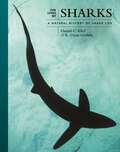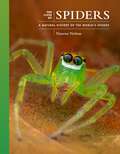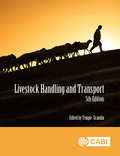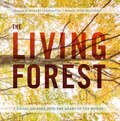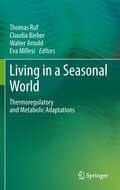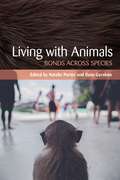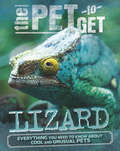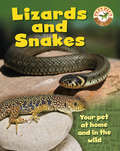- Table View
- List View
The Lives of Moths: A Natural History of Our Planet's Moth Life (The Lives of the Natural World #1)
by Andrei Sourakov Rachel Warren ChaddA richly illustrated look at the natural history of mothsMoths are among the most underappreciated insects on the planet, yet they make up the majority of some 180,000 known species of Lepidoptera. Filled with striking images, The Lives of Moths looks at the remarkable world of these amazing and beautiful creatures.While butterflies may get more press than moths, Andrei Sourakov and Rachel Warren Chadd reveal that the lopsided attention is unjust. Moths evolved long before butterflies, and their importance cannot be overestimated. From the tiniest leaf miners to exotic hawk moths that are two hundred to three hundred times larger, these creatures are often crucial pollinators of flowers, including many that bloom at night or in twilight. The authors show that moths and their larvae are the main food source for thousands of animal species, and interact with other insect, plant, and vertebrate communities in ecosystems around the world, from tropical forests and alpine meadows to deserts and wetlands. The authors also explore such topics as evolution, life cycles, methods of communication, and links to humans.A feast of remarkable facts and details, The Lives of Moths will appeal to insect lovers everywhere.
The Lives of Octopuses and Their Relatives: A Natural History of Cephalopods (The Lives of the Natural World #8)
by Danna StaafAn engaging and beautifully illustrated introduction to some of the world’s most interesting and charismatic marine creaturesDive deep into the fascinating world of cephalopods—octopuses, squid, cuttlefish, and the mysterious nautilus—to discover the astonishing diversity of this unique group of intelligent invertebrates and their many roles in the marine ecosystem. Organized by marine habitat, this book features an extraordinary range of these clever and colorful creatures from around the world and explores their life cycles, behavior, adaptations, ecology, links to humans, and much more. With stunning photographs and illustrations as well as profiles of selected species, The Lives of Octopuses and Their Relatives is a comprehensive, authoritative, and inviting introduction to the natural history of these charismatic creatures.
The Lives of Seaweeds: A Natural History of Our Planet's Seaweeds and Other Algae (The Lives of the Natural World #4)
by Julie A. PhillipsAn engaging and richly illustrated exploration of the natural history of seaweeds and other algaeAs photosynthetic organisms, seaweeds and other algae transfer billions of tons of carbon globally from the atmosphere to the deep ocean each year. Coming in all manner of colors, shapes, and sizes, from bioluminescent single-celled algae to giant kelps, they form the basis of most marine food webs, and are found in almost all environments on the planet. Touted as the biofuel of the future, seaweeds and algae also hold promise for biodegradable packaging, offer a nutritious food source, and exhibit antiviral and antitumor properties.Combining accessible text with stunning images and graphics, this book takes a deep dive to explore the unique characteristics of seaweeds and other algae, outlining their extraordinary evolution as well as their morphology, life histories, ecology, and uses. Offering rare insights into the algal world, The Lives of Seaweeds is essential reading for naturalists and marine life enthusiasts.
The Lives of Sharks: A Natural History of Shark Life (The Lives of the Natural World #7)
by Daniel C. Abel Dr. R. Dean GrubbsA richly illustrated and comprehensive introduction to the world’s sharksSharks are the top predators in many marine ecosystems. But tales of the killer instincts and fearsomely sharp senses of these hunters can obscure their full life histories. In fact, sharks are characterful, exhibit surprisingly complex behaviors, and lead secretive lives full of interest in every type of marine habitat. The Lives of Sharks is a fascinating and beautifully illustrated guide to these iconic marine creatures from two world-renowned experts. This book explores shark physiology, anatomy, behavior, ecology, and evolution, as well as conservation and the impact of human activity on shark populations. With stunning photographs and illustrations, as well as profiles of selected species, this is a comprehensive, authoritative, and inviting introduction to global shark life today.
The Lives of Spiders: A Natural History of the World's Spiders (The Lives of the Natural World #11)
by Dr. Ximena NelsonA beautifully illustrated guide to the natural history and breathtaking diversity of spiders around the worldSpiders are dominant predators in virtually every terrestrial ecosystem on the planet. A marvel of evolution with species numbering in the tens of thousands, they have been walking the earth since before the dinosaurs. Spiders manipulate the silk strands of their webs to act as a sensory field, which vibrates across wide frequencies that they can read in detail, while young spiders spin silk lines that interact with the electrical fields in the atmosphere, enabling them to balloon across huge distances. Some spiders even gather in groups to impersonate ants in astonishing displays of collective mimicry. The Lives of Spiders explores these and other wonders, blending stunning imagery, lively writing, and the latest science to explore the natural history of the world&’s diverse arachnid life.Features a wealth of color illustrationsSheds invaluable light on the life history, ecology, and stunning diversity of spidersCovers silk and web building, venoms, predators and prey, mating and dancing, spider cognition, and much moreDiscusses the impacts of human activity on spiders
Livestock and Literature: Reimagining Postanimal Companion Species (Palgrave Studies in Animals and Literature)
by Liza B. BauerThis book explores the past and current traces that cows, pigs, chickens, and other animals used by humans have left in Anglophone literary fiction. In times of accelerated global warming, an acute pandemic, and breakthroughs in bioengineering practices, discussions on how to rethink the relationships to these animals have become as heated as perhaps never before. Livestock and Literature examines what literature has to contribute to these debates. In particular, it draws on counter-narratives to so-called livestock animals’ commodification in selected science- and speculative fiction (SF) works from the twenty-first century. These texts imagine ‘what if’ scenarios where “livestock” practice resistance, transform into biotechnologically modified, postanimal beings, or live in close companionship to humans. Via these three points of access, the study delineates the formal and thematic strategies SF authors apply to challenge anthropocentric and speciesist thought patterns. The aim is to shed light on how these alternative storyworlds expand readers’ understanding of the lives of farmed animals; seeking insight into how literature shapes human-animal relationships beyond the page.
Livestock and Wealth Creation: Improving The Husbandry Of Animals Kept By Resource-poor People In Developing Countries
by E OwenThis unique textbook is the product of a south/north, east/west collaboration, involving 105 contributors from 26 countries. It will be invaluable to all concerned with livestock keeping and poverty alleviation in developing countries, especially lecturers, students, NGOs, policy makers and those working with resource-poor livestock-keepers.
Livestock Biodiversity: Genetic Resources for the Farming of the Future
by Stephen J. HallLivestock biodiversity is integral to our culture, history, environment, economy and, most importantly, our future. Thousands of livestock breeds, from relatively small genetic pools, have evolved over time to suit particular environments and farming systems. This is both the result of natural processes and of human needs for specialized livestock – as our knowledge of genetics continues to increase we achieve a greater understanding of how this biodiversity evolved. This book offers a detailed and comprehensive overview of livestock biodiversity. It explores the history behind it, shows how livestock biodiversity can be utilized as animal genetic resources through breed development and by crossbreeding, examines the state of world livestock biodiversity today, and emphasizes the importance of conserving and developing the biodiversity of livestock. Special consideration is given to: • How livestock biodiversity arose and is maintained in relation to human society • How it can be used in sustainable agricultural development • How it can be conserved for the benefit of present and future generations • Why conservation biologists, as well as agriculturists, should be involved in its protection
Livestock Handling and Transport: Principles And Practice
by Adrian Barber Faith Baier Keith Belk Donald Broom Michelle S. Calvo-Lorenzo Michael Cockram Lorna Coppinger Raymond Coppinger Trevor DeVries Roger Ewbank Luigi Faucitano Robert B. Freeman Wendy K Fulwider Carmen Gallo Arlene Garcia-Marquez Peter Goddard Paul Hemsworth Stella Maris Huertas Anna Johnson Katherine A. Houpt Geoffrey D. Hutson Mateus J.R. Costa Miriam Parker Clive Phillips Matthew J. Ritter Karen Schwartzkopf-Genswein Meagan King E. Bert Lambooij Genaro C. Lama Pol Llonch Obiols Edmond A. Pajor Emma Fabreger Romans Frank Tuyttens Antonio Velarde Kurt Vogel Claire A Weeks Carissa L. WickensEdited by world-renowned animal scientist Dr Temple Grandin, this practical book integrates scientific research and industry literature on cattle, pigs, poultry, sheep, goats, deer, and horses, in both the developed and developing world, to provide a practical guide to humane handling and minimizing animal stress. Reviewing the latest research on transport systems, restraint methods and facilities for farms and slaughterhouses, this fully updated fifth edition of Livestock Handling and Transport includes five new chapters: The Introduction, Genetics and Handling, Goat Handling and Transport, Robotic Milking, and Transport of Livestock by Sea. There is also new coverage of temperament testing and change, the principles of good stockmanship as well as including new video material to further explain key information contained in the book. Key features include: - Edited by world-renowned animal scientist Temple Grandin. - Two new chapters on the testing and control of temperament and the principles of good stockmanship. - Online videos to further illustrate the key points.
Livestock Production and Climate Change
by Cadaba S PrasadIn a changing climate, livestock production is expected to exhibit dual roles of mitigation and adaptation in order to meet the challenge of food security. This book approaches the issues of livestock production and climate change through three sections: I. Livestock production, II. Climate change and, III. Enteric methane amelioration. Section I addresses issues of feed quality and availability, abiotic stress (heat and nutritional) and strategies for alleviation, livestock generated nitrogen and phosphorus pollution, and approaches for harnessing the complex gut microbial diversity. Section II discusses the effects of climate change on livestock diversity, farm animal reproduction, impact of meat production on climate change, and emphasising the role of indigenous livestock in climatic change to sustain production. Section III deals with the most recent approaches to amelioration of livestock methane such as breeding for low methane emissions, reductive acetogenesis, immunization/vaccine-based concepts and archaea phage therapy.
Livestock Ration Formulation for Dairy Cattle and Buffalo
by Ravinder Singh Kuntal Radha Gupta D. Rajendran Vishal PatilLivestock Ration Formulation for Dairy Cattle and Buffalo provides an interdisciplinary, integrative perspective and optimization on dairy cattle feed formulation problem solving. It helps dairy farmers by introducing them the right frequency and right amount of balanced diet to be fed to cattle’s and buffaloes at different body condition so that their feeding cost should be decreased and there should be increase in income for dairy farmers, as they don’t have enough knowledge of feeding practice. It helps animal nutritionist to work for dairy farmers which have very limited feed resources to fulfil nutrients requirement in terms of crude protein (CP), total digestible nutrient (TDN), calcium (Ca) and phosphorus (P) by developing a software programme to plan a balanced low budget diet. It includes the Linear and Goal programming model for non-pregnant dairy buffalo is been solved using Hybrid Real Coded Genetic Algorithm and the results are compared with Real Coded Genetic Algorithm (RGA) considering different versions like RGA without crossover, RGA without Mutation, RGA with crossover and mutation. These models can also be applied with other nutritional models like CNCPS, INRA. This book is a step forward in that direction to provide least cost diet formulation based on nutrient requirement of the cattle and buffalo, which is been calculated according to Indian Council of Agricultural Research (ICAR, 2013) and NRC (2001) on dry matter basis, provides a clear and precise platform for other researcher in Animal Nutrition field which also give initial platform to build a software and android application to formulate least cost ration Based on data and algorithm used in this book, which helps Dairy farmers directly to feed balanced diet at cheap rate. Features: It is a good reference to local dairy farmers by introducing them to the right frequency and right amount of balanced diet to be fed to cattle and buffaloes at different production cycles. It will provide basic platform and some solutions to built-up software about cattle nutrition development and least cost formulation for end-user. It has several techniques for optimizing animal diet formulation but a good balance between coding/programming and animal nutrition is incorporated towards application of soft computing technique to improve the quality of the solution due to rigidity of the constraints.
Livestock Ration Formulation for Dairy Cattle and Buffalo
by Ravinder Singh Kuntal Radha Gupta D. Rajendran Vishal PatilLivestock Ration Formulation for Dairy Cattle and Buffalo provides an interdisciplinary, integrative perspective and optimization on dairy cattle feed formulation problem solving. It helps dairy farmers by introducing them the right frequency and right amount of balanced diet to be fed to cattle’s and buffaloes at different body condition so that their feeding cost should be decreased and there should be increase in income for dairy farmers, as they don’t have enough knowledge of feeding practice. It helps animal nutritionist to work for dairy farmers which have very limited feed resources to fulfil nutrients requirement in terms of crude protein (CP), total digestible nutrient (TDN), calcium (Ca) and phosphorus (P) by developing a software programme to plan a balanced low budget diet. It includes the Linear and Goal programming model for non-pregnant dairy buffalo is been solved using Hybrid Real Coded Genetic Algorithm and the results are compared with Real Coded Genetic Algorithm (RGA) considering different versions like RGA without crossover, RGA without Mutation, RGA with crossover and mutation. These models can also be applied with other nutritional models like CNCPS, INRA. This book is a step forward in that direction to provide least cost diet formulation based on nutrient requirement of the cattle and buffalo, which is been calculated according to Indian Council of Agricultural Research (ICAR, 2013) and NRC (2001) on dry matter basis, provides a clear and precise platform for other researcher in Animal Nutrition field which also give initial platform to build a software and android application to formulate least cost ration Based on data and algorithm used in this book, which helps Dairy farmers directly to feed balanced diet at cheap rate. Features: It is a good reference to local dairy farmers by introducing them to the right frequency and right amount of balanced diet to be fed to cattle and buffaloes at different production cycles. It will provide basic platform and some solutions to built-up software about cattle nutrition development and least cost formulation for end-user. It has several techniques for optimizing animal diet formulation but a good balance between coding/programming and animal nutrition is incorporated towards application of soft computing technique to improve the quality of the solution due to rigidity of the constraints.
The Living Elephants: Evolutionary Ecology, Behaviour, and Conservation
by Raman SukumarThe Living Elephants is the authoritative resource for information on both Asian and African elephants. From the ancient origins of the proboscideans to the present-day crisis of the living elephants, this volume synthesizes the behavior, ecology and conservation of elephants, while covering also the history of human interactions with elephants, all within the theoretical framework of evolutionary biology. The book begins with a survey of the 60-million year evolutionary history of the proboscideans emphasizing the role of climate and vegetation change in giving rise to a bewildering array of species, but also discussing the possible role of humans in the late Pleistocene extinction of mastodonts and mammoths. The latest information on the molecular genetics of African and Asian elephants and its taxonomic implications are then presented. The rise of the elephant culture in Asia, and its early demise in Africa are traced along with an original interpretation of this unique animal-human relationship. The book then moves on to the social life of elephants as it relates to reproductive strategies of males and females, development of behavior in young, communication, ranging patterns, and societal organization. The foraging strategies of elephants, their impact on the vegetation and landscape are then discussed. The dynamics of elephant populations in relation to hunting for ivory and their population viability are described with the aid of mathematical models. A detailed account of elephant-human interactions includes a treatment of crop depredation by elephants in relation to their natural ecology, manslaughter by elephants, habitat manipulation by humans, and a history of the ivory trade and poaching in the two continents. The ecological information is brought together in the final chapter to formulate a set of pragmatic recommendations for the long-term conservation of elephants. The broadest treatment of the subject yet undertaken, by one of the leading workers in the field, Raman Sukumar, the book promises to bring the understanding of elephants to a new level. It should be of interest not only to biologists but also a broader audience including field ecologists, wildlife administrators, historians, conservationists and all those interested in elephants and their future.
The Living Forest: A Visual Journey Into the Heart of the Woods
by Robert Llewellyn Joan MaloofIn a winning combination of fine-art photography and short, lyrical essays, The Living Forest reveals the top-to-bottom mystery, beauty, and interconnectedness of the forest.
Living in a Dynamic Tropical Forest Landscape
by Nigel Stork Stephen M. TurtonThis book brings together a wealth of scientific findings and ecological knowledge to survey what we have learned about the “Wet Tropics” rainforests of North Queensland, Australia. This interdisciplinary text is the first book to provide such a holistic view of any tropical forest environment, including the social and economic dimensions. The most thorough assessment of a tropical forest landscape to date Explores significant scientific breakthroughs in areas including conservation genetics, vegetation modeling, agroforestry and revegetation techniques, biodiversity assessment and modeling, impacts of climate change, and the integration of science in natural resource management Research achieved, in part, due to the Cooperative Research Centre for Tropical Rainforest Ecology and Management (the Rainforest CRC) Written by a number of distinguished international experts contains chapter summaries and section commentaries
Living in a Seasonal World: Thermoregulatory and Metabolic Adaptations
by Thomas Ruf, Claudia Bieber, Walter Arnold and Eva MillesiThis book summarises the newest information on seasonal adaptation in animals. Topics include animal hibernation, daily torpor, thermoregulation, heat production, metabolic depression, biochemical adaptations, neurophysiology and energy balance. The contributors to this book present interdisciplinary research at multiple levels ranging from the molecular to the ecophysiological, as well as evolutionary approaches. The chapters of this book provide original data not published elsewhere, which makes it the most up-to-date, comprehensive source of information on these fields. The book’s subchapters correspond to presentations given at the 14th International Hibernation Symposium in August 2012 in Austria. This is a very successful series of symposia (held every four years since 1959) that attracts leading researchers in the field. Like the past symposia, this meeting – and consequently the book – is aimed not only at hibernation but at covering the full range of animal adaptations to seasonal environments. For the next four years, this book will serve as the cutting-edge reference work for graduate students and scientists active in this field of physiology and ecology..
Living in a Tree: Independent Reading Non-Fiction Pink 1a (Reading Champion #515)
by Jackie WalterThis book is part of Reading Champion, a series carefully linked to book bands to encourage independent reading skills, developed with UCL Institute of Education (IOE)Living in a Tree is a non-fiction text exploring the different animals that live in trees. The repeated sentence structure offers readers the opportunity for a very first independent reading experience with the support of the illustrations.Reading Champion offers independent reading books for children to practise and reinforce their developing reading skills.This early non-fiction text is accompanied by engaging artwork and a reading activity. Each book has been carefully graded so that it can be matched to a child's reading ability, encouraging reading for pleasure.
Living in the Sound of the Wind: A Personal Quest for W.H. Hudson, Naturalist and Writer from the River Plate
by Jason WilsonW. H. Hudson was brought up on the pampas, where he learnt from gauchos about frontier life. After moving to London in 1874, Hudson lived in extreme poverty. Like his friend Joseph Conrad, Hudson was an exile, adapting to England. He never returned to Argentina.Wilson unravels Hudson’s English dream, his natural history rambles, and his work to protect birds. He remains both a complex witness to his homeland before mass immigration and to his England of the mind, before the urban sprawl.Praise for Jason Wilson: Tireless, shrewd, erudite Jason Wilson, mixing hard fact and anthology, provides the perfect outfit of allusion and comparative experience - Jonathan Keates, ObserverPut his treasure trove into your pocket. - Anthony Sattin, Sunday TimesThe idea is so simple that it must be original. This inaugural book might prove to be a landmark. - Nicholas Shakespeare, Daily Telegraph
Living on One Acre or Less: How to produce all the fruit, veg, meat, fish and eggs your family needs
by Sally MorganAn accessible and comprehensive guide, filled with everything you need to set up your own mini-farm and live more self-sufficiently.With the help of this handy book, you can grow all the fruit and vegetables your family needs, raise animals for meat and eggs, keep fish and bees, and even produce firewood on a plot of land of just one acre or less – all alongside your work and family life.Whether you have a garden, a paddock or perhaps the corner of a field, Sally Morgan guides you through various useful topics, including growing fruit and vegetables throughout the year, producing fish with aquaponics, and keeping livestock – poultry, pigs, sheep and goats. There is also helpful information on how to layout your plot, including fencing, poly tunnels or greenhouses, and tips on managing soil fertility. This updated edition also includes a chapter on coping with extreme weather conditions.Filled with practical advice, Living on One Acre or Less is essential reading for anyone who aspires to take control of their food supply or who wants to do more with the land they've got.
Living Together: The Biology of Animal Parasitism
by W. TragerWilliam Trager has been an avid student of parasites for over 50 years at the Rockefeller University. Around the turn of this century, parasitology enjoyed a certain vogue, inspired by colonial responsibilities of the technically ad vanced countries, and by the exciting etiological and therapeutic discoveries of Ross, Manson, Ehrlich, and others. For some decades, the Western hemi sphere's interest in animal parasites has been eclipsed by concern for bacteria and viruses as agents of transmissible disease. Only very recently, initiatives like the Tropical Disease Research programs of WHO-World Bank-UNDP, and the Great Neglected Disease networks of the Rockefeller and MacArthur Foundations have begun to compensate for the neglect of these problems by United States federal health research agencies. Throughout that period, how ever, the Rockefeller Institute (later University) has given high priority to the challenges of parasitism, corresponding during a formidable period with Dr. Trager's own career. The present work then, is a distillation of the insight collected by our principal doyen of parasite biology, informed but by no means confined to his own research. It is addressed to the reader of broad biological interest and training, not to the specialist. The disarmingly unpretentious style makes the work readily accessible to college undergraduates or even to gifted high school students; but do not be deceived thereby, as it has an enormous range of factual information and theoretical insight, familiar to few, but potentially important to most biologists.
Living with an Older Dog: Gentle Dog Care
by David Alderton Derek HallMost dogs live longer these days, thanks to a greater understanding of what they need in terms of food, exercise, health monitoring, and medical care.This book describes how to recognise and understand the changes - both mental and physical - that occur as your dog grows older. It explains - with the help of unique and specially-commissioned photography - how to manage these changes successfully, and thus how to make the senior canine years more enjoyable and fulfilling for both you and your dog. Exercise, diet, grooming, sharing the house with a younger dog, travel and holiday arrangements - all this and much more is covered in detail. There is also advice on how to work closely with your vet in order to manage your dog's senior years, as well as sympathetic advice for when the time comes to say goodbye.Includes: Physical and behavioural changes â ¢ General care â ¢ Feeding the older dog â ¢ Using your vet â ¢ Diseases and the older dog â ¢ Special care â ¢ When it's time to say goodbye â ¢ Glossary of terms
Living with Animals: Bonds across Species
Living with Animals is a collection of imagined animal guides—a playful and accessible look at different human-animal relationships around the world. Anthropologists and their co-authors have written accounts of how humans and animals interact in labs, in farms, in zoos, and in African forests, among other places. Modeled after the classic A World of Babies, an edited collection of imagined Dr. Spock manuals from around the world—With Animals focuses on human-animal relationships in their myriad forms.This is ethnographic fiction for those curious about how animals are used for a variety of different tasks around the world. To be sure, animal guides are not a universal genre, so Living with Animals offers an imaginative solution, doing justice to the ways details about animals are conveyed in culturally specific ways by adopting a range of voices and perspectives. How we capitalize on animals, how we live with them, and how humans attempt to control the untamable nature around them are all considered by the authors of this wild read.If you have ever experienced a moment of "what if" curiosity—what is it like to be a gorilla in a zoo, to work in a pig factory farm, to breed cows and horses, this book is for you. A light-handed and light-hearted approach to a fascinating and nuanced subject, Living with Animals suggests many ways in which we can and do coexist with our non-human partners on Earth.
Lizard: Lizard (The Pet to Get #1)
by Rob ColsonFind out what lizards are like as pets and what care they will need. Information is provided on housing, feeding and grooming and other essential elements of pet care. Learn all about lizards with advice from how to choose the right breed and find the right cage, to keeping your lizard happy and healthy. Also included are amazing fact files about specific species. Fantastic photographs bring the animals to life!
Lizards and Snakes (Pets Plus)
by Sally MorganPets Plus is a pet care series with a difference. Each title in this attractive series offers a comprehensive look at pet care as well as comparing the behaviour of domestic animals to that of their cousins in the wild. Clear colour photography and an appealing visual layout make these books very appealing to young readers.



